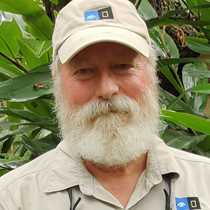Godthul & Cumberland Bay
We spent the day in the middle region of the northern coast of South Georgia. First thing this morning, the National Geographic Explorer entered into what the Norwegians called “Good Cove,” so named because it affords a nice, protected anchorage. There is much evidence of the past presence of those same Norwegians here in Godthul in the form of rusted ruins and whale bones from the early 20th century. This beautiful bay proved itself an especially good cove for us this morning, and we offered a variety of activities, including kayaking, Zodiac cruises, hiking, and beach walking.
The hikers had to first wind their way upwards through thick tussock grass containing cute, fuzzy, mobile land mines (also known as fur seal pups…see image above), before breaking out onto an incredibly scenic succession of hills surrounded by towering, snow-dusted sandstone mountains. We could see two separate herds of reindeer meandering along the far slopes and then marvelled at their fluid grace as they coalesced into a single entity and trotted from one side of the huge valley to the other. On the broad ridge overlooking the bay above the landing we found a picturesque lake that the whalers of old had dammed to use as their source for the steam needed in the whaling operations down at shoreside. The kayakers had a great time exploring along the coast among kelp beds and playful fur seals, and the Zodiac cruises took us close to the steep cliffs for a chance to see…well, everything.
During lunch, we rounded Rookery Point and sailed into Cumberland Bay, and then anchored near the ruins of Grytviken. This famous whaling station was established in 1904 by Carl Larsen (captain of Nordenskjold’s ill-fated Swedish Antarctic expedition of 1901-1903) after he convinced British and Norwegian backers to finance the establishment. It was so successful, six other whaling stations were established in bays along the northern coast within just a few years. Near to the Grytviken station ruins is King Edward Point, where the government officer, his staff, and about a dozen BAS personnel live. Once we had completed the necessary officialdom, a landing was made near the whaler’s cemetery to pay homage to Ernest Shackleton (The Boss) at his final resting place. The rest of the afternoon was left open to hike up the valley, wander about with the photography team, explore the ruins of the whaling station, visit the excellent museum (the taxidermied wandering albatross was very impressive…see author’s image below), ring the bell in the old Norwegian church, walk around to King Edward Point, etc. Several members of the local populace joined us onboard tonight for drinks and dinner and a good time was had by all.




